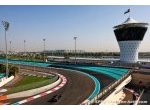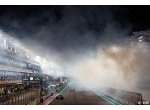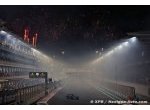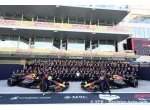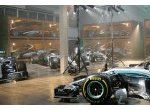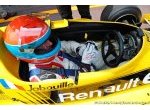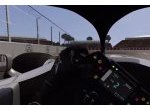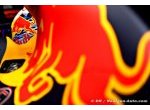Spain 2015 - GP Preview - Renault F1
Team quotes
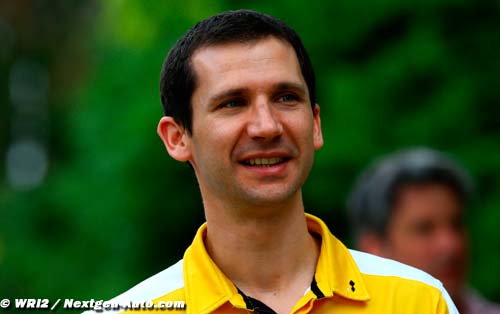
Fuel consumption in Barcelona is relatively low. Corners are mid to high speed and the momentum is generally carried through the turns, in stark contrast to the point-squirt nature of the first few circuits visited this year. Race fuel saving is expected to be low and similar to Malaysia and much less critical than Melbourne and Bahrain.
After the Bahrain GP the air and sea freight returning from the overseas races was unpacked, with parts sent for checks and investigation where necessary. The fresh freight was then loaded onto three Renault trucks and taken by road to Barcelona.
Around 60GB of data is received and processed by the Viry operations room over a GP weekend for one team alone!
Renault engines have won in Barcelona on 11 occasions. Ayrton Senna won in 1986 with the V6-powered Lotus 98T while the V10 proved dominant between 1991 and 1995, and again in 1997. The V8 powered a further four wins, the first coming in 2006 and between 2010 and 2012.
Power Unit details
ICE
The Circuit de Catalunya sits in the middle of the table for the demands placed on the PU. Only 45% of the track is taken at full throttle, the lowest percentage of the season so far.
The 1km long pit straight stresses the ICE for around 12secs, but its effects are mitigated by only short bursts of throttle round the rest of the 4.655km circuit.
The only other period of significant throttle comes between Turns 9 and 10, where the ICE will be at close to maximum revs for some 5secs.
Speeds on these two straights will peak at over 300kph with DRS open, with the maximum speed being just over 325kph on the main straight. Ultimate top speed will depend on the wind direction, however. If there is a head wind, the top speed will be some 1-4kph lower than with a tail wind. Engineers work to offset the negative effect with minute aero adjustments since gear ratios cannot be changed. This nonetheless affects car balance as a compromise needs to be found; a strong tailwind down the main straight is less detrimental than a headwind.
Turbocharger
Maintaining good driveability over the lap from the turbo is important as the circuit flows a lot better than the modern tracks visited so far. Turn 3, for instance, is taken almost flat out and the driver needs to be able to carry the speed through the corner.
Turn 10, the 70kph hairpin requires good turbo response to provide smooth torque delivery and ensure a good exit. Also, traction out of the last corner is arguably more important than top speed to enable an overtaking manoeuvre, which is typically difficult at this circuit.
The undulating nature of the track likewise requires good turbo reponse. The first sector rises in altitude by some 15m before descending through sector two. Power delivery up the hill needs to be smooth, but likewise sharp on the exit of the corners.
MGU-K
The circuit has a variety of corner speeds and there are good opportunities for the MGU-K to recover energy under braking. The first is the Turn 1 to 3 complex. The cars arrive at over 300kph and brake to 125kph for the first corner.
Another notable chance to recover energy is Turn 5, located in sector 2. The circuit drops down hill, giving the car further momentum, and the driver steps on the brakes for around 3secs. A peak torque of 600Nm is requested from the brakes, an average 30% of which is recovered from the MGU-K in the braking zone.
Other braking points come at Turn 10 and Turn 13. T10 is one of the hardest braking zones on the track as the driver will be at 300kph at the entry to the corner. As well as ensuring the MGU-K is recovering as much energy as possible, PU torque accuracy is particularly important here as the circuit goes downhill. Giving the right amount of stability under braking while giving push on the exit is one of the key challenges of the track.
MGU-H
Barcelona is not a particularly challenging circuit for the MGU-H as the pit and back straight will give the MGU-H time to recover the energy lost in the exhaust.
Other short bursts between the turns and high speed corners such as Turns 6 and 9 likewise see the ICE running at partial throttle for extended periods of time.
Rémi Taffin, Director of Operations
Barcelona is much more of a traditional circuit than the first four tracks we have visited so far this year. The layout flows a lot more, with high and medium speed corners rather than tight, slow hairpins and long straights. It also has changes of altitude as the track follows the contours of the hills. As such, the circuit represents medium difficulty for the Power Units, which subsequently have to deliver good all-round performance across all the parts.
The three week gap has given us an opportunity to look at all the information from the start of the season. We have been flat out to counter the issues encountered early on and we will have a modified spec of engine for this race that should give improved reliability and driveability. We are looking forward to Spain to see our hard work in action.
Focus on...European GP 1997
Spain has hosted two races per year in the past. In addition to the Spanish GP, which has been held at Barcelona since 1991, Valencia and Jerez also welcomed F1 over a number of years under the guise of the European GP. In 1997 Jerez was given the ultimate honour: the season finale.
The F1 fraternity went to Jerez on tenterhooks. The championship had been hugely competitive. Renault-powered Williams and Jacques Villeneuve had started the season strongly with a string of pole positions, but Michael Schumacher, Mika Hakkinen and David Coulthard had all taken points on race day. A strong run of finishes and one win from Villeneuve’s team-mate Heinz-Harald Frentzen had also put him in a strong position and when the circus arrived in Spain, Villeneuve and Schumacher had a shot at the title.
In the Renault camp, securing the title was important – it would be the sixth consecutive constructors’ title for the French manufacturer. At the time, it was to be the last as Renault had decided to withdraw from the sport at the end of the year. It had returned to F1 in 1989 and in less than 10 years had dominated the sport. Former managing director, Jean-François Caubet, was at Jerez at the time. ’We came back to the sport in 1989. Renault had decided on an aggressive communications strategy as it became an international company. We needed to reinforce our image, explore new terrain, and three major partnerships were confirmed. The first was with EuroDisney, the second with the Winter Olympics and then in Formula 1. There was lots of pressure to succeed in F1, and Patrick Faure decided on a big partnership with Williams.
’From the start, the quality and scope of the Williams relationship on a technical and human level was extraordinary. The partnership was really defined by the quality of the relationship. Bernard Dudot, Jean-Jacques His and Patrick Faure put together innovative technology to compete against the likes of Ferrari, Honda, Ford...and there was a big co-operation on every level.
’I particularly remember three strong moments. In 1993 with Prost winning the championship, then of course Senna’s accident in 1994. We really had to consider long and hard whether we could stay in the sport. it was a very hard time. Then, the third, was the 1997 race in Jerez.
’We went there having won everything – around 75% of the races had been won by a Renault engine between 1995 and 1997 and we’d had five consecutive titles. In the end, Louis Schweitzer and Patrick Faure said we needed to stop F1 as we had nothing left to prove. Jerez was our last race. We had asked Bernie to have the last race in Europe for a large TV audience, and we wanted to win and leave in front. We had a huge party on the Saturday night with all the drivers and paddock to celebrate the end of the era, but it was the race that really counted.
’We had arrived in Jerez with Michael Schumacher in front and Jacques [Villeneuve] needed to win, or finish ahead of him to take the championship. The field was close though, as Schumacher, Coulthard, Frentzen, Jacques...they had all won races. In the race I remember Michael went out in the lead, but some 20 laps before the end Jacques came in for a tyre change. He was much quicker than Michael and closed the gap, but he needed to overtake to get the title. After a second stop he was closer again, and going into a corner he tried a move. Schumacher went into the side of him – we couldn’t believe it in the garage. We were folded over in two, thinking it was over.
’Jacques continued but there was then a worry with his car. It was too tense for words, and he got overtaken by Coulthard and then Hakkinen. He needed to be third at least to get the title, so we couldn’t watch. He got there in the end; a massive relief but also a wonderful end to the season and, at the time, our F1 involvement. We’d achieved what we needed and went out on a high. But in the plane on the way back to Paris, Schweitzer turned to Faure and said... ’so, when are we coming back to F1 then...?’’
